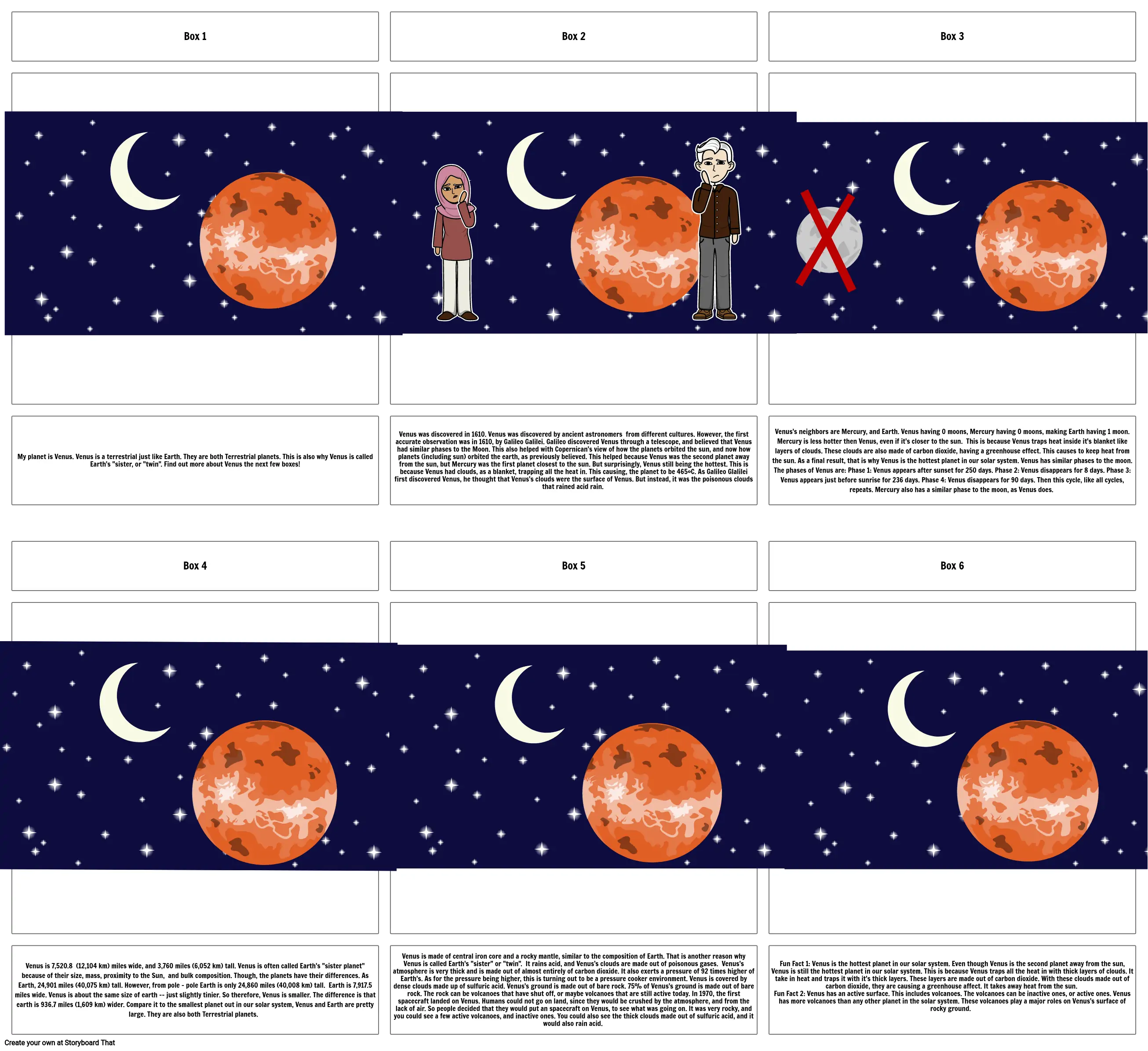Solar Systems Project

Texto del Guión Gráfico
- Box 1
- Box 2
- Box 3
- My planet is Venus. Venus is a terrestrial just like Earth. They are both Terrestrial planets. This is also why Venus is called Earth's "sister, or "twin". Find out more about Venus the next few boxes!
- Box 4
- Venus was discovered in 1610. Venus was discovered by ancient astronomers from different cultures. However, the first accurate observation was in 1610, by Galileo Galilei. Galileo discovered Venus through a telescope, and believed that Venus had similar phases to the Moon. This also helped with Copernican's view of how the planets orbited the sun, and now how planets (including sun) orbited the earth, as previously believed. This helped because Venus was the second planet away from the sun, but Mercury was the first planet closest to the sun. But surprisingly, Venus still being the hottest. This is because Venus had clouds, as a blanket, trapping all the heat in. This causing, the planet to be 465°C. As Galileo Glalilei first discovered Venus, he thought that Venus's clouds were the surface of Venus. But instead, it was the poisonous clouds that rained acid rain.
- Box 5
- Venus's neighbors are Mercury, and Earth. Venus having 0 moons, Mercury having 0 moons, making Earth having 1 moon. Mercury is less hotter then Venus, even if it's closer to the sun. This is because Venus traps heat inside it's blanket like layers of clouds. These clouds are also made of carbon dioxide, having a greenhouse effect. This causes to keep heat from the sun. As a final result, that is why Venus is the hottest planet in our solar system. Venus has similar phases to the moon. The phases of Venus are: Phase 1: Venus appears after sunset for 250 days. Phase 2: Venus disappears for 8 days. Phase 3: Venus appears just before sunrise for 236 days. Phase 4: Venus disappears for 90 days. Then this cycle, like all cycles, repeats. Mercury also has a similar phase to the moon, as Venus does.
- Box 6
- Venus is 7,520.8 (12,104 km) miles wide, and 3,760 miles (6,052 km) tall. Venus is often called Earth's "sister planet" because of their size, mass, proximity to the Sun, and bulk composition. Though, the planets have their differences. As Earth, 24,901 miles (40,075 km) tall. However, from pole - pole Earth is only 24,860 miles (40,008 km) tall. Earth is 7,917.5 miles wide. Venus is about the same size of earth -- just slightly tinier. So therefore, Venus is smaller. The difference is that earth is 936.7 miles (1,609 km) wider. Compare it to the smallest planet out in our solar system, Venus and Earth are pretty large. They are also both Terrestrial planets.
- Venus is made of central iron core and a rocky mantle, similar to the composition of Earth. That is another reason why Venus is called Earth's "sister" or "twin". It rains acid, and Venus’s clouds are made out of poisonous gases. Venus's atmosphere is very thick and is made out of almost entirely of carbon dioxide. It also exerts a pressure of 92 times higher of Earth's. As for the pressure being higher, this is turning out to be a pressure cooker environment. Venus is covered by dense clouds made up of sulfuric acid. Venus's ground is made out of bare rock. 75% of Venus's ground is made out of bare rock. The rock can be volcanoes that have shut off, or maybe volcanoes that are still active today. In 1970, the first spacecraft landed on Venus. Humans could not go on land, since they would be crushed by the atmosphere, and from the lack of air. So people decided that they would put an spacecraft on Venus, to see what was going on. It was very rocky, and you could see a few active volcanoes, and inactive ones. You could also see the thick clouds made out of sulfuric acid, and it would also rain acid.
- Fun Fact 1: Venus is the hottest planet in our solar system. Even though Venus is the second planet away from the sun, Venus is still the hottest planet in our solar system. This is because Venus traps all the heat in with thick layers of clouds. It take in heat and traps it with it's thick layers. These layers are made out of carbon dioxide. With these clouds made out of carbon dioxide, they are causing a greenhouse affect. It takes away heat from the sun. Fun Fact 2: Venus has an active surface. This includes volcanoes. The volcanoes can be inactive ones, or active ones. Venus has more volcanoes than any other planet in the solar system. These volcanoes play a major roles on Venus's surface of rocky ground.
Más de 30 millones de guiones gráficos creados

